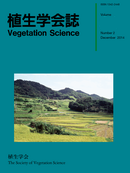Volume 15, Issue 1
Displaying 1-8 of 8 articles from this issue
- |<
- <
- 1
- >
- >|
-
Article type: Article
1998Volume 15Issue 1 Pages 1-5
Published: June 25, 1998
Released on J-STAGE: January 06, 2017
Download PDF (575K) -
Article type: Article
1998Volume 15Issue 1 Pages 7-17
Published: June 25, 1998
Released on J-STAGE: January 06, 2017
Download PDF (1576K) -
Article type: Article
1998Volume 15Issue 1 Pages 19-32
Published: June 25, 1998
Released on J-STAGE: January 06, 2017
Download PDF (1511K) -
Article type: Article
1998Volume 15Issue 1 Pages 33-45
Published: June 25, 1998
Released on J-STAGE: January 06, 2017
Download PDF (1663K) -
Article type: Article
1998Volume 15Issue 1 Pages 47-59
Published: June 25, 1998
Released on J-STAGE: January 06, 2017
Download PDF (1423K)
-
Article type: Article
1998Volume 15Issue 1 Pages 61-64
Published: June 25, 1998
Released on J-STAGE: January 06, 2017
Download PDF (408K) -
Article type: Article
1998Volume 15Issue 1 Pages 65-70
Published: June 25, 1998
Released on J-STAGE: January 06, 2017
Download PDF (748K) -
Article type: Article
1998Volume 15Issue 1 Pages 71-77
Published: June 25, 1998
Released on J-STAGE: January 06, 2017
Download PDF (461K)
- |<
- <
- 1
- >
- >|
